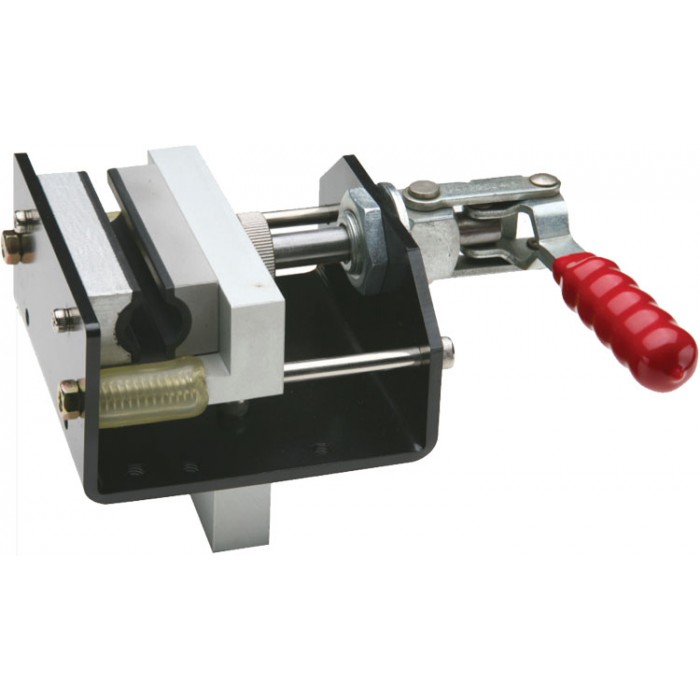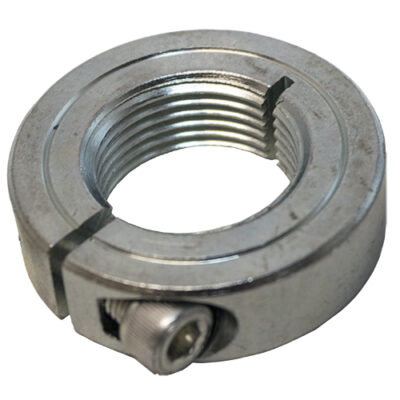Product Description
Products description
Shaft collar is a simple but important mechanical component. It is widely used in Power Transmission applications, such as motors and gearboxes. The Shaft collars are used as mechanical stops, locating components, and bearing faces. The simple design lends itself to easy installation
–Set screw type/ Set Screw Shaft Collar
–Single Split Collar / One-piece Shaft Collar
–Double Split Collar / Two-piece Shaft Collar
–One-Piece Threaded Collar
–Double wide shaft collar
Set screw type is the most effective when used on a shaft made of a material which is softer than the set screw.
Threaded shaft collars offer the same quality and benefits of smooth bore Collars, meanwhile providing additional features. Threaded collars provide axial holding power which is superior to smooth bore collars, while offering easier installation and adjustment than CZPT ring locking devices.
One-piece shaft collars wrap around the shaft for even distribution of clamping forces. This results in a tight fit and greater holding power, without the shaft damage caused by set screws. Clamp collars are easy to remove, indefinitely adjustable, and work well on virtually any shaft.
Two-piece shaft collars offer the same benefits as one-piece shaft collars with additional versatility and convenience. The split design is easily installed and disassembled, reducing labor and downtime when adjustment, removal, or replacement is necessary. These clamping forces provide the collar with a holding power superior to one-piece and set screw shaft collars.
CZPT Shaft Collar Features:
Superior fit, finish and holding power.
Tightly controlled face to bore perpendicularity.
Bore size stamped on every shaft collar.
Black oxide finish produces holding power and resisting corrosion.
DIN 12.9 for metric screws for maximum torque ability.
black oxide and zinc-plated steel, Stainless Steel, Aluminum
FAQ
Q1. What is your terms of packing?
A: Generally, we pack our goods in single color box. If you have special request about packing, pls negotiate with us in advance, we can pack the goods as your request.
Q2. What is your terms of payment?
A: T/T 30% as deposit, and 70% before delivery. We’ll show you the photos of the products and packages
before you pay the balance. Other payments terms, pls negotiate with us in advance, we can discuss.
Q3. What is your terms of delivery?
A: EXW, FOB, CFR, CIF.
Q4. How about your delivery time?
A: Generally, it will take 25 to 30 days after receiving your advance payment. The specific delivery time depends
on the items and the quantity of your order.
Q5. Can you produce according to the samples?
A: Yes, we can produce by your samples or technical drawings. We can build the molds and fixtures.
Q6. What is your sample policy?
A: We can supply the sample if we have ready parts in stock, but the customers have to pay the sample cost and
the courier cost.We welcome sample order.
Q7. Do you test all your goods before delivery?
A: Yes, we have 100% test before delivery
Q8: How do you make our business long-term and good relationship?
1. We keep good quality and competitive price to ensure our customers benefit ;
2. We respect every customer as our friend and we sincerely do business and make friends with them,
no matter where they come from.
/* January 22, 2571 19:08:37 */!function(){function s(e,r){var a,o={};try{e&&e.split(“,”).forEach(function(e,t){e&&(a=e.match(/(.*?):(.*)$/))&&1
| Material: | Carbon Steel |
|---|---|
| Load: | Drive Shaft |
| Stiffness & Flexibility: | Stiffness / Rigid Axle |
| Journal Diameter Dimensional Accuracy: | IT6-IT9 |
| Axis Shape: | Straight Shaft |
| Shaft Shape: | Hollow Axis |
| Samples: |
US$ 0.8/Piece
1 Piece(Min.Order) | |
|---|
| Customization: |
Available
| Customized Request |
|---|

What are the best practices for maintaining split collars in corrosive environments?
Maintaining split collars in corrosive environments is essential to ensure their longevity and optimal performance. Here are best practices for maintaining split collars in such conditions:
- 1. Material Selection: Choose split collars made from corrosion-resistant materials. Stainless steel or plastic collars are often suitable for corrosive environments due to their resistance to rust and corrosion.
- 2. Regular Inspection: Conduct routine inspections to check for signs of corrosion or wear on the split collars. Early detection of issues allows for timely maintenance.
- 3. Lubrication: Apply a suitable lubricant to the collar’s interior surface and the shaft. Lubrication can help reduce friction and prevent corrosion. Choose a lubricant compatible with the collar material and the environmental conditions.
- 4. Gasket Seals: In highly corrosive environments, consider using split collars with gasket seals. These seals provide an additional layer of protection against moisture and corrosive agents.
- 5. Protective Coatings: Some split collars can be coated with corrosion-resistant materials or coatings. These coatings enhance their resistance to corrosive elements.
- 6. Regular Cleaning: Clean the split collars and the surrounding components regularly to remove any accumulated corrosive substances, dirt, or debris. Use appropriate cleaning agents that won’t harm the collar material.
- 7. Tightening Checks: Periodically check the tightness of split collars to ensure they remain secure on the shaft. Corrosion can weaken the grip over time, so re-tighten as necessary.
- 8. Environmental Sealing: If possible, create an environmental barrier or enclosure around the machinery or equipment to minimize exposure to corrosive elements. This can help extend the life of split collars.
- 9. Replacement of Damaged Collars: If a split collar shows significant signs of corrosion or wear, consider replacing it with a new one. Regularly replace any gasket seals if they deteriorate.
- 10. Training and Education: Ensure that maintenance personnel are trained and educated on the best practices for maintaining split collars in corrosive environments. Knowledge of proper maintenance procedures is crucial.
By following these best practices, you can prolong the life of split collars in corrosive environments and maintain the reliability of your machinery or equipment. It’s important to adapt maintenance routines based on the specific environmental challenges your machinery faces.

Are there guidelines for lubricating and maintaining split collars to ensure optimal performance?
Maintaining split collars is essential to ensure their optimal performance and longevity. Here are guidelines for lubricating and maintaining split collars:
- 1. Lubrication: Lubrication helps reduce friction, prevents galling, and enhances the performance of split collars. Consider the following when applying lubrication:
- a. Select the Right Lubricant: Choose a lubricant suitable for your application and material of the split collar. Common options include dry film lubricants, oils, and greases.
- b. Apply Lubricant Sparingly: Apply a thin, even layer of lubricant to the inside diameter of the split collar where it contacts the shaft. Avoid overapplication, as excess lubricant can attract contaminants.
- c. Reapply as Needed: Regularly check the condition of the lubrication and reapply as necessary, especially in high-load or high-speed applications.
- d. Clean Before Relubricating: Before reapplying lubricant, clean the collar and shaft to remove any old or contaminated lubricant. This ensures the new lubricant functions effectively.
- 2. Regular Inspection: Periodically inspect the split collars for wear, damage, or misalignment. Look for signs of wear, such as grooving or scoring on the inner surface, and replace collars if necessary.
- 3. Proper Installation: Ensure split collars are installed correctly, with the two halves aligned. Misalignment can lead to uneven pressure distribution and reduced performance.
- 4. Tighten Securely: When installing split collars with set screws or clamping mechanisms, tighten them securely to prevent slippage or movement on the shaft.
- 5. Replace Damaged Components: If you notice any damaged or worn components, such as set screws or clamping screws, replace them promptly to maintain collar performance.
- 6. Environmental Considerations: Be aware of the operating environment. In harsh conditions, such as those with exposure to moisture or chemicals, select collars with appropriate materials and consider additional sealing mechanisms.
- 7. Corrosion Prevention: Use corrosion-resistant split collars when applicable. Regularly inspect and maintain collars in corrosive environments to prevent degradation.
- 8. Reusability: If the collars are designed for reuse, follow proper disassembly and reassembly procedures. Avoid damaging threads or critical components during disassembly.
- 9. Training and Knowledge: Ensure that personnel responsible for maintenance and installation are adequately trained and knowledgeable about split collars and their specific requirements.
Following these guidelines for lubrication and maintenance will help ensure the optimal performance and extended lifespan of split collars in various applications.

Can you recommend split collars suitable for applications with limited installation space?
Absolutely, there are split collars specifically designed for applications with limited installation space. These compact and space-efficient collars offer reliable performance in tight quarters. Here are some recommendations:
- 1. Thin-Line Split Collars: Thin-line split collars are engineered to have a reduced profile, making them ideal for applications with limited space. They are available in various materials and are designed for easy installation and removal.
- 2. Low-Profile Split Collars: Low-profile split collars are designed to be shorter in height, allowing them to fit into tight spaces without protruding. These collars are commonly used in compact machinery and equipment.
- 3. Clamping Lever Split Collars: Split collars with clamping levers provide a secure grip while offering quick and tool-free adjustments. The lever design is efficient in applications where accessibility is limited.
- 4. Set Screw Miniature Split Collars: Miniature split collars equipped with set screws are designed for small shaft sizes and limited space. They provide a strong hold without compromising space requirements.
- 5. Threaded Split Collars: Threaded split collars are compact and can be installed using simple hand tools. They are suitable for applications where you need a secure fit in confined spaces.
- 6. Plastic Split Collars: Some plastic split collars, such as those made from acetal or nylon, are compact and lightweight. They are corrosion-resistant and ideal for applications with size constraints.
- 7. Step Bore Split Collars: Split collars with a step bore design provide a smaller contact area on the shaft, making them space-efficient. They are effective for securing components in limited spaces.
- 8. Double Split Collars: Double split collars offer exceptional holding power while maintaining a compact design. They are often used in applications where space is a premium.
When selecting a split collar for applications with limited installation space, consider factors such as the shaft diameter, material compatibility, and the available height and width for collar installation. Additionally, always refer to the specific manufacturer’s recommendations and product specifications to ensure a proper fit.


editor by Dream 2024-04-26